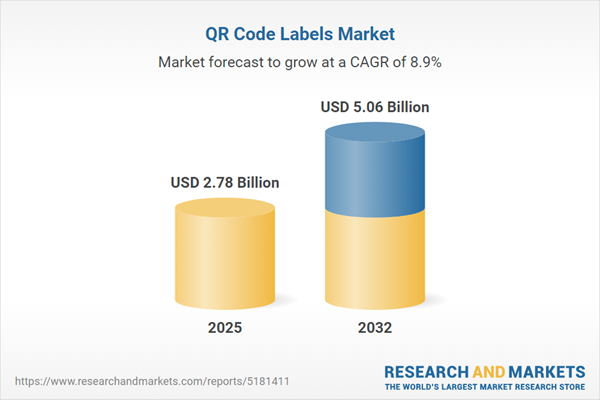Speak directly to the analyst to clarify any post sales queries you may have.
The QR Code Labels Market is advancing enterprise operations by enabling seamless digital traceability and compliance through integrated labeling solutions. As companies navigate evolving regulatory demands and digital workflows, QR code labels serve as a strategic foundation for secure data exchange and improved process oversight.
Market Snapshot: QR Code Labels Market Growth and Outlook
Robust expansion in the QR Code Labels Market is driven by digital transformation initiatives across manufacturing, logistics, and retail sectors. These industries capitalize on QR code technologies to achieve enhanced asset visibility and elevate process verification. The adoption of advanced digital QR labels supports transparent supply chain management by facilitating seamless data transfers and promoting audit readiness. Growth extends across both established and emerging regions, guided by two forces: ongoing innovation and the imperative to comply with evolving regulations. Senior executive investment continues to accelerate workflow evolution, positioning QR code solutions as central to resilient business models prepared for rapid change.
Scope & Segmentation: Key Categories for Senior Leaders
A nuanced segmentation framework gives enterprises a strategic advantage, guiding targeted technology deployment and robust risk management. Each segment highlights distinct operational priorities, supporting tailored decision-making across the QR Code Labels Market.
- QR Code Types: Dynamic QR labels empower continuous content updates and adaptable operations; static QR labels optimize asset identification and ensure traceability.
- Material Types: Paper, PET, and PVC deliver targeted durability and compliance, addressing diverse industry requirements and regulatory standards.
- Printing Technologies: Inkjet, laser, and thermal printing adapt QR labels to various volumes, durability demands, and enterprise-specific applications.
- Interactivity Levels: Single-use options safeguard data and ensure asset integrity, while reusable solutions support efficient, multi-stage tracking across supply chains.
- Data Capacity: Numeric and alphanumeric formats integrate seamlessly with IT systems, driving efficient business process automation.
- Distribution Channels: Direct procurement, distributor networks, and digital platforms supply scalable, flexible order fulfillment for projects ranging from niche to large scale.
- Applications: Industries employ QR code labels for packaging, scenario-based inventory management, asset tracking, marketing, logistics, and industrial communication, broadening the market’s operational relevance.
- Organization Size: Solutions are designed for both multinational enterprises and small-to-midsized businesses, ensuring regulatory compliance and tailored deployments.
- Regions Covered: The Americas, Europe, Middle East & Africa, and Asia-Pacific each demonstrate unique regulatory frameworks and diverse rates of technology adoption, influencing strategy.
- Companies Profiled: Leading vendors, including PACKTICA SDN BHD, CCL Industries Inc., Zebra Technologies Corporation, and Multi-Color Corporation, spearhead advances in QR code labeling technology.
Key Takeaways: Strategic Insights for Decision-Makers
- Mobile-enabled QR code labels grant teams immediate access to critical operational information, fostering responsive, cross-functional collaboration and process optimization.
- Organizations can easily adapt to changing compliance requirements through dynamic QR code features, minimizing workflow disruption and maintaining business continuity.
- Integrated QR code labels—when connected with IoT infrastructure—deliver expanded supply chain transparency, supporting detailed audit preparedness in regulated verticals.
- Selecting the right materials and print technologies ensures sustainable procurement, aligning asset management with responsible sourcing initiatives and extended product lifecycles.
- Strategic collaboration with technology partners accelerates system integration, enhancing print infrastructure and ensuring high performance for enterprise stakeholders.
- Agile procurement models—spanning direct, distributive, and digital channels—help companies maintain resilient and adaptive supply chains amidst rapidly evolving trade environments.
Tariff Impact: Managing Cost and Supply Chain Dynamics
Recent tariff changes in the United States have elevated the material costs related to QR code label production. In response, enterprises are renegotiating supplier contracts and transitioning manufacturing operations closer to end-user markets, allowing them to uphold product quality while exercising cost control across supply chains.
Methodology & Data Sources
This report is developed through a multi-phase approach that incorporates primary market data, comprehensive patent analysis, and direct consultation with leading industry specialists. All results undergo peer review to ensure actionable and compliance-oriented market intelligence for the QR Code Labels Market.
Why This Report Matters
- Equips executive leadership with actionable insight to anticipate regulatory and technological shifts, improving enterprise risk oversight and control.
- Provides strategic guidance for procurement and supply chain improvement, advancing business resilience and optimizing workflow efficiency across organizational tiers.
- Presents scalable, compliant QR code labeling solutions that align with sustainability objectives and varied enterprise demands, supporting responsible growth.
Conclusion
QR code labels help enterprises streamline workflows and reinforce supply chain visibility. These digital solutions foster operational agility while meeting the evolving demands of digital transformation and compliance.
Additional Product Information:
- Purchase of this report includes 1 year online access with quarterly updates.
- This report can be updated on request. Please contact our Customer Experience team using the Ask a Question widget on our website.
Table of Contents
3. Executive Summary
4. Market Overview
7. Cumulative Impact of Artificial Intelligence 2025
Companies Mentioned
The companies profiled in this QR Code Labels market report include:- PACKTICA SDN BHD
- CCL Industries Inc.
- Barspell Technologies India Private Limited
- Bashyam Graphic Technologies Pvt Ltd. A
- Coast Label Company
- Creative Labels, Inc.
- Consolidated Label & Co.
- Custom Labels Ltd
- EE Labels
- Fastroll Labels Sdn. Bhd
- GSM Graphic Arts Ltd,
- Herma Gmbh
- Hibiscus plc
- Labels Unlimited Company
- Multi-Color Corporation
- MustHaveMenus Inc.
- N D R Labels
- Roemer Industries, LLC
- S.A Packaging PVT LTD
- SBE
- VistaPrint
- Zebra Technologies Corporation
Table Information
| Report Attribute | Details |
|---|---|
| No. of Pages | 198 |
| Published | October 2025 |
| Forecast Period | 2025 - 2032 |
| Estimated Market Value ( USD | $ 2.78 Billion |
| Forecasted Market Value ( USD | $ 5.06 Billion |
| Compound Annual Growth Rate | 8.8% |
| Regions Covered | Global |
| No. of Companies Mentioned | 23 |









